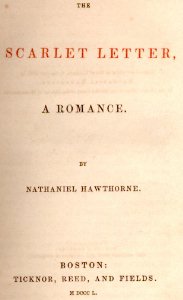 |
| Image from wikipedia.org |
The Scarlet Letter, Nathaniel Hawthorne's 1850 novel about sin, guilt, and judgement in a 17th century Puritan colony, is not an easy read. Hawthorne's attempt at imitating how people (presumably) spoke in the 1600s combined with a very 1800s tendency for long and complicated sentences makes this novel heavy going, not to mention unintentionally humorous at times, especially when little Pearl is speaking, and the plodding plot and heavy-handed imagery don't help things.
The novel tells the story of Hester Prynne, who has an affair and gives birth to an illegitimate daughter, Pearl. Living in Puritan Massachusetts, this doesn't go over well with the society at large, especially as she refuses to divulge the name of the child's father. As punishment, Hester is forced to wear the letter A on her breast as a sign of her crime.
Personally, I didn't find much to like about this novel, but Hester as a character was an exception. I admired her strength and how she got on with things despite being ostracised by society, and the rebellious way she embroidered the scarlet letter so it was almost more an adornment than a symbol of shame. Because of Hester's skill as a seamstress, she was offered work despite being in disgrace, which made it possible for her to support herself and her daughter, just one example of Puritan hypocrisy.
The daughter, Pearl, is continuously referred to as a fairy child and unnatural in some way, and even Hester seems afraid of her a times. A lot of the time Hawthorne uses her to spell out uncomfortable truths, which at times reduces her to more of a symbol than a character. (Not that this happens only with Pearl.)
Of the other characters, the villain of the piece, if you can even call him that, is Hester's long-lost husband who takes the name Roger Chillingworth and swears to discover the father of the child while working as the town physician. The father, the town minister Arthur Dimmesdale, is a weakling who lets Hester suffer alone while his guilt eats at him from the inside.
The novel examines the nature of sin and the injustice of Hester's punishment and questions the rules of the intensely religious Puritan society that wreck the lives of everyone involved. Hester does find a sort of redemption in the end, even if she never quite shrugs off the weight of the scarlet letter, while Dimmesdale's guilt destroys him. In Dimmesdale's case, I doubt even the Puritan legal system would have been harder on him than he was on himself.
Concerning writer tricks, Hawthorne is famous for his use of metaphor in the novel, but I found him quite heavy-handed. Every time he does something particularly clever, he seems to have a need to point it out to the reader in a very unsubtle hey-look-what-I-did-there way. For examples of this, see the bit where he compares Pearl to the roses on the prison wall to the scarlet letter and the scene where the scarlet letter appears in the sky. I did like the use of colour and light and darkness in the novel. For me, this novel also served as a reminder of what not to do: even if you're writing a historical novel, it doesn't mean you need to make the prose so archaic that it takes away from the reader's experience.
So all in all, not exactly the book for me. But hey, I did learn you can use the word "pillory" as a verb!
Classics read: 30/100
Speaking of oppressed female heroes in other space-times... The Handmaid's Tale, which you have written about, is now showing in Canada and the U.S. as a ten episode series.
ReplyDeleteIt's getting written about in the newspapers; it sounds exciting. I haven't seen it yet. The main character is played by Elizabeth Moss from Mad Men.
Yeah, it looks really well done, and I love Elizabeth Moss. I hope we'll see it in Finland at some point.
Delete